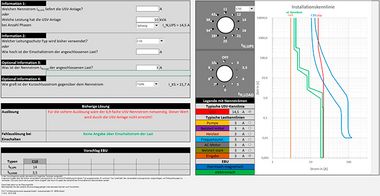Planning tool
for calculating the secondary protection of UPS applications
The topic of energy security plays a central role in the industry and is discussed on a large scale. Topics such as the energy transition and renewable energies support this. We need electricity to produce goods, generate data and communicate. Without exception. That is why many industrial companies rely on a UPS. The undervoltage supply ensures permanent energy security even in the event of a power failure or power fluctuation and protects against data loss.
The dilemma
For all their advantages, AC UPS systems also have their downsides. In addition to high investment costs, the main problem is that the output power provided is limited for technical reasons. Therefore, the UPS can only provide limited overcurrent beyond the rated current.
If the load is too high due to a short circuit, the maximum load limit of the UPS is exceeded very quickly. The entire UPS switches off for reasons of self-protection. In this case, the original purpose of the system, energy security, is no longer fulfilled. In the event of a single faulty load circuit, this ensures that all other loads can also no longer be supplied. This can lead to a plant shutdown. Undefined states with all the associated dangers can be the result.
Secondary overcurrent protection that does not trip in the event of a fault favors this situation and also offers no personal protection. Conventional circuit breakers (miniature circuit breakers) are often used. In this overload situation, these react too slowly, only unreliably or not at all. The reason for this is that a conventional protective element requires a relatively high current to trip. The UPS, however, can only provide a specified limited current.
The solution for stable energy security
With the circuit breaker type EBU you ensure the energy security for industrial enterprises by AC UPS systems stable for the first time. The product is available in the LS rated currents 4A, 6 A, 10 A and 16 A characteristic B and C and is operated directly at the feeder of the respective UPS.
With the help of an adjustment potentiometer, it can be adapted to the capacity of the respective UPS system and the existing load conditions in just a few steps. In the event of a fault, it trips reliably.
